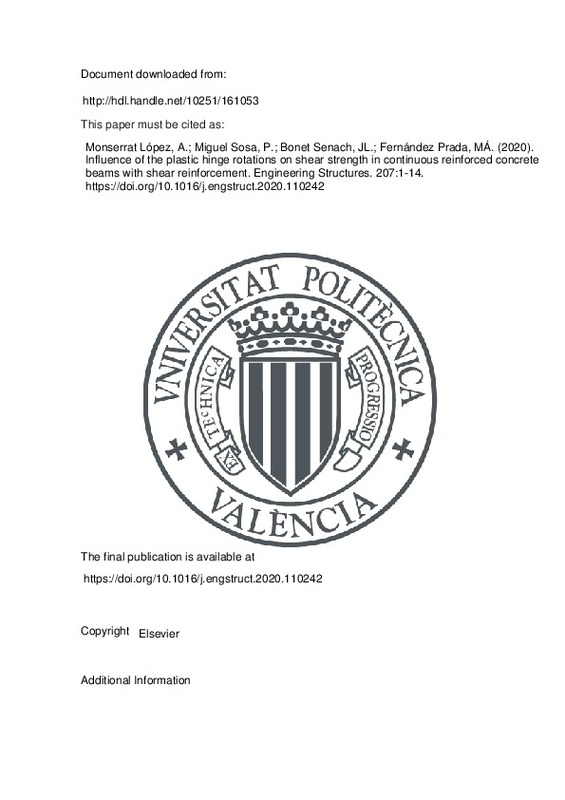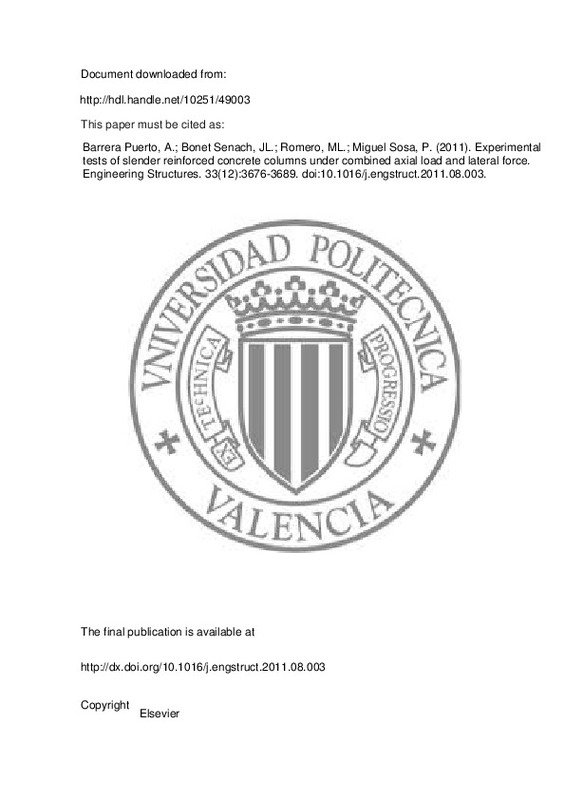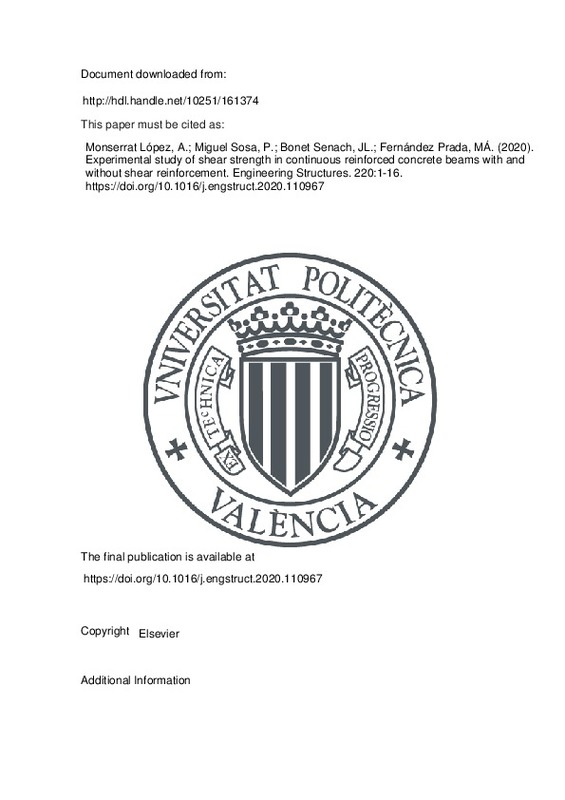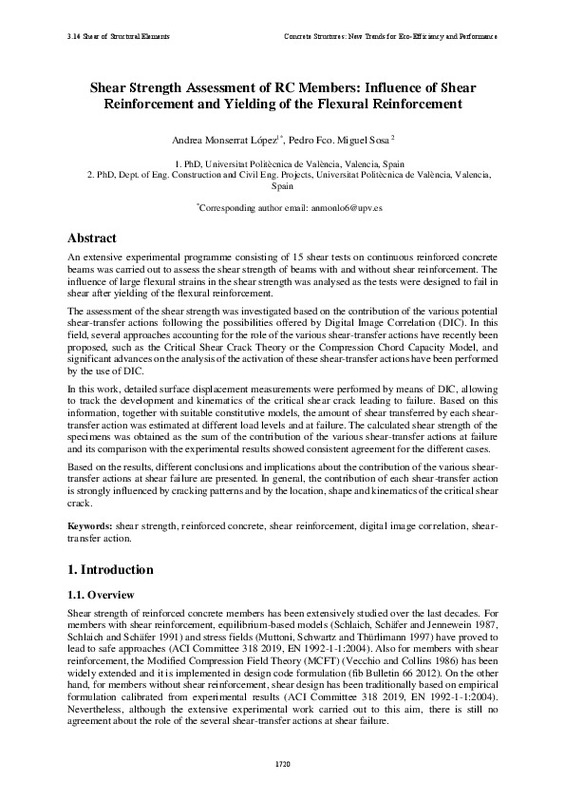JavaScript is disabled for your browser. Some features of this site may not work without it.
Buscar en RiuNet
Listar
Mi cuenta
Estadísticas
Ayuda RiuNet
Admin. UPV
Influence of the plastic hinge rotations on shear strength in continuous reinforced concrete beams with shear reinforcement
Mostrar el registro sencillo del ítem
Ficheros en el ítem
| dc.contributor.author | Monserrat López, Andrea
|
es_ES |
| dc.contributor.author | Miguel Sosa, Pedro
|
es_ES |
| dc.contributor.author | Bonet Senach, José Luís
|
es_ES |
| dc.contributor.author | Fernández Prada, Miguel Ángel
|
es_ES |
| dc.date.accessioned | 2021-02-11T04:32:26Z | |
| dc.date.available | 2021-02-11T04:32:26Z | |
| dc.date.issued | 2020-03-15 | es_ES |
| dc.identifier.issn | 0141-0296 | es_ES |
| dc.identifier.uri | http://hdl.handle.net/10251/161053 | |
| dc.description.abstract | [EN] Continuous reinforced concrete (RC) beams may develop significant plastic rotations to enable the redistribution of bending moments. These rotations occur at plastic hinges, which are subject to high shear forces. The influence of rotations on the shear strength for statically determined beams without shear reinforcement failing in shear after yielding of the flexural reinforcement has already been experimentally verified. However, this influence has not been studied in continuous members with shear reinforcement. An innovative tests system has been specially designed to develop shear failures before and after yielding of the flexural reinforcement in both statically determinate and indeterminate structures. Nine beams (9000 mm long, 250 mm wide, 450 mm high) with a shear reinforcement of phi 8/30 (rho(w) = 0.13%) and different longitudinal reinforcement ratios were tested under different load and support conditions. The shear strength provided by shear reinforcement and that provided by the other mechanisms of resistance (shear strength provided by concrete) for each specimen were calculated based on the critical shear crack width measurements performed by Digital Image Correlation (DIC). Bending rotation and crack rotation along the development length of the critical shear crack were also obtained by DIC. Based on the test results, the shear strength provided by concrete was studied in relation to the bending rotation and the average crack width in reinforced concrete beams with shear reinforcement. It was confirmed that the shear strength provided by concrete decreased with increasing both bending rotations and crack widths. The shear strength values predicted by different design codes (ACI 318-19, Eurocode 2 and Model Code 2010) were compared with the test results, and showed that these formulations did not properly capture the loss of shear strength caused by bending rotation. | es_ES |
| dc.description.sponsorship | This research was funded with grants from the Spanish Ministry of Economy and Competitiveness to Research Project BIA2015-64672-C4-4-R. The experimental programme was developed in the Laboratory of Concrete of the Institute of Concrete Science and Technology (ICITECH) of the Universitat Politecnica de Valencia (UPV), with concrete supplied by Caplansa. Andrea Monserrat was supported by the Conselleria d'Educacio, Investigacio, Cultura i Esport of the Generalitat Valenciana (Order 6/2015, DOCV no. 7615 15.09.2015) with European Regional Development Funds (ERDF) allocated by the EU. | es_ES |
| dc.language | Inglés | es_ES |
| dc.publisher | Elsevier | es_ES |
| dc.relation.ispartof | Engineering Structures | es_ES |
| dc.rights | Reconocimiento - No comercial - Sin obra derivada (by-nc-nd) | es_ES |
| dc.subject | Shear test | es_ES |
| dc.subject | Shear strength | es_ES |
| dc.subject | Reinforced concrete | es_ES |
| dc.subject | Continuous beam | es_ES |
| dc.subject | Shear reinforcement | es_ES |
| dc.subject | Plastic hinge | es_ES |
| dc.subject.classification | INGENIERIA DE LA CONSTRUCCION | es_ES |
| dc.title | Influence of the plastic hinge rotations on shear strength in continuous reinforced concrete beams with shear reinforcement | es_ES |
| dc.type | Artículo | es_ES |
| dc.identifier.doi | 10.1016/j.engstruct.2020.110242 | es_ES |
| dc.relation.projectID | info:eu-repo/grantAgreement/MINECO//BIA2015-64672-C4-4-R/ES/EVALUACION EXPERIMENTAL DE VIGAS CONTINUAS PRETENSADAS, CON Y SIN REFUERZO, Y PIEZAS COMPUESTAS DE DOS HORMIGONES, PARA LA EXTENSION DE SU VIDA UTIL./ | es_ES |
| dc.rights.accessRights | Abierto | es_ES |
| dc.contributor.affiliation | Universitat Politècnica de València. Instituto de Ciencia y Tecnología del Hormigón - Institut de Ciència i Tecnologia del Formigó | es_ES |
| dc.contributor.affiliation | Universitat Politècnica de València. Departamento de Ingeniería de la Construcción y de Proyectos de Ingeniería Civil - Departament d'Enginyeria de la Construcció i de Projectes d'Enginyeria Civil | es_ES |
| dc.description.bibliographicCitation | Monserrat López, A.; Miguel Sosa, P.; Bonet Senach, JL.; Fernández Prada, MÁ. (2020). Influence of the plastic hinge rotations on shear strength in continuous reinforced concrete beams with shear reinforcement. Engineering Structures. 207:1-14. https://doi.org/10.1016/j.engstruct.2020.110242 | es_ES |
| dc.description.accrualMethod | S | es_ES |
| dc.relation.publisherversion | https://doi.org/10.1016/j.engstruct.2020.110242 | es_ES |
| dc.description.upvformatpinicio | 1 | es_ES |
| dc.description.upvformatpfin | 14 | es_ES |
| dc.type.version | info:eu-repo/semantics/publishedVersion | es_ES |
| dc.description.volume | 207 | es_ES |
| dc.relation.pasarela | S\406584 | es_ES |
| dc.contributor.funder | Generalitat Valenciana | es_ES |
| dc.contributor.funder | European Regional Development Fund | es_ES |
| dc.contributor.funder | Ministerio de Economía y Competitividad | es_ES |
| dc.description.references | Lopes, S. M., & do Carmo, R. N. F. (2006). Deformable strut and tie model for the calculation of the plastic rotation capacity. Computers & Structures, 84(31-32), 2174-2183. doi:10.1016/j.compstruc.2006.08.028 | es_ES |
| dc.description.references | Schlaich, J., Schafer, K., & Jennewein, M. (1987). Toward a Consistent Design of Structural Concrete. PCI Journal, 32(3), 74-150. doi:10.15554/pcij.05011987.74.150 | es_ES |
| dc.description.references | Vecchio, F. J. (2000). Disturbed Stress Field Model for Reinforced Concrete: Formulation. Journal of Structural Engineering, 126(9), 1070-1077. doi:10.1061/(asce)0733-9445(2000)126:9(1070) | es_ES |
| dc.description.references | Leondardt, F. (1965). Reducing the shear reinforcement in reinforced concrete beams and slabs. Magazine of Concrete Research, 17(53), 187-198. doi:10.1680/macr.1965.17.53.187 | es_ES |
| dc.description.references | Walraven, J. C. (1981). Fundamental Analysis of Aggregate Interlock. Journal of the Structural Division, 107(11), 2245-2270. doi:10.1061/jsdeag.0005820 | es_ES |
| dc.description.references | Dei Poli, S., Di Prisco, M., & Gambarova, P. G. (1990). Stress Field in Web of RC Thin‐Webbed Beams Failing in Shear. Journal of Structural Engineering, 116(9), 2496-2514. doi:10.1061/(asce)0733-9445(1990)116:9(2496) | es_ES |
| dc.description.references | Campana, S., Fernández Ruiz, M., Anastasi, A., & Muttoni, A. (2013). Analysis of shear-transfer actions on one-way RC members based on measured cracking pattern and failure kinematics. Magazine of Concrete Research, 65(6), 386-404. doi:10.1680/macr.12.00142 | es_ES |
| dc.description.references | Fernández Ruiz, M., Muttoni, A., & Sagaseta, J. (2015). Shear strength of concrete members without transverse reinforcement: A mechanical approach to consistently account for size and strain effects. Engineering Structures, 99, 360-372. doi:10.1016/j.engstruct.2015.05.007 | es_ES |
| dc.description.references | Cavagnis, F., Fernández Ruiz, M., & Muttoni, A. (2017). An analysis of the shear-transfer actions in reinforced concrete members without transverse reinforcement based on refined experimental measurements. Structural Concrete, 19(1), 49-64. doi:10.1002/suco.201700145 | es_ES |
| dc.description.references | Muttoni, A., Fernández Ruiz, M., & Simões, J. T. (2017). The theoretical principles of the critical shear crack theory for punching shear failures and derivation of consistent closed-form design expressions. Structural Concrete, 19(1), 174-190. doi:10.1002/suco.201700088 | es_ES |
| dc.description.references | Marí, A., Cladera, A., Bairán, J., Oller, E., & Ribas, C. (2014). Shear-flexural strength mechanical model for the design and assessment of reinforced concrete beams subjected to point or distributed loads. Frontiers of Structural and Civil Engineering, 8(4), 337-353. doi:10.1007/s11709-014-0081-0 | es_ES |
| dc.description.references | Fédération International du Béton (fib). Model Code 2010. Ernst & Sohn; 2012. | es_ES |
| dc.description.references | CEN, EN 1992-1-1:2004. Eurocode 2: Design of concrete structures - Part 1-1: General rules and rules for buildings; 2004. | es_ES |
| dc.description.references | UNE EN-12390-3:2009. “Ensayos de hormigón endurecido. Parte 3: Determinación de la resistencia a compresión del hormigón endurecido; 2009. | es_ES |
| dc.description.references | UNE EN-12390-6:2010. Ensayos de hormigón endurecido. Parte 6: Resistencia a tracción indirecta de probetas; 2010. | es_ES |
| dc.description.references | UNE EN-12390-13:2014. Ensayos de hormigón endurecido. Parte 13: Determinación del módulo secante de elasticidad en compression; 2014. | es_ES |
| dc.description.references | UNE-EN ISO 6892-1:2017. Materiales metálicos. Ensayo de tracción. Parte 1: Ensayo a temperatura ambiente; 2017. | es_ES |
| dc.description.references | Huber, P., Huber, T., & Kollegger, J. (2016). Investigation of the shear behavior of RC beams on the basis of measured crack kinematics. Engineering Structures, 113, 41-58. doi:10.1016/j.engstruct.2016.01.025 | es_ES |
| dc.description.references | Simões, J. T., Fernández Ruiz, M., & Muttoni, A. (2018). Validation of the Critical Shear Crack Theory for punching of slabs without transverse reinforcement by means of a refined mechanical model. Structural Concrete, 19(1), 191-216. doi:10.1002/suco.201700280 | es_ES |







![[Cerrado]](/themes/UPV/images/candado.png)




